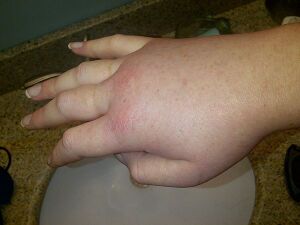Hereditary Angioedema
|
This article was marked by its author as Under construction, but the last edit is older than 30 days. If you want to edit this page, please try to contact its author first (you fill find him in the history). Watch the discussion as well. If the author will not continue in work, remove the template Last update: Thursday, 05 May 2022 at 12.15 pm. |
Hereditary angioedema (C1 inhibitor deficiency, OMIM: 106100) is a genetic disease of the immune system with autosomal dominant inheritance. This is not a classic immunodeficiency, in which the affected individual would be exposed to a higher risk of infectious disease, but it is a hereditary disease of the immune system, where a mutation in the gene for one of the components of the immune system damages its carrier.
Pathogenesis[edit | edit source]
The mutation affects the complement component C1 inhibitor gene (C1-INH, localization 11q11-q13.1). The product of the mutated gene is either not formed at all or is non-functional. This means that every stimulus (albeit minimal and harmless such as a minor injury) leads to the activation of the entire complement cascade, the clinical manifestations are responsible for increased bradykinin production, which is normally regulated by inhibition of prekallikrein to kallikrein conversion by C1-INH.
Clinical picture[edit | edit source]
Externally, the disease manifests itself in swelling of the subcutaneous tissue and mucous membranes, which are pale, itchy, without a local increase in temperature. Swelling of the mucous membranes of the respiratory tract can be dangerous, gastrointestinal mucosa can cause indigestion, in severe form pain and partial intestinal obstruction and mimic a sudden abdominal event, urinary tract mucosa is at risk of urinary retention.
The disease has a later onset, sometimes in adulthood.
Diagnosis[edit | edit source]
The diagnosis is based on the demonstration of low levels of the C4 component of complement (due to consumption) and very low (in the non-functional form of C1-INH also normal or high) levels of C1-INH.
Differential diagnosis[edit | edit source]
It is necessary to differentiate the acquired forms differentially - paraneoplastic (consumption of C1-INH in tumor tissue), parainfectious (rarely in Hellicobacter pylori infection) and drug (in ACEI therapy up to 0.3−1 %)
Therapy[edit | edit source]
The B2R receptor antagonist bradykinin is used in acute treatment.- icatibant s.c. and i.v. C1-INH substitution. Antifibrinolytics (tranexamic acid) and danazol (ethinyltestosterone derivative) are used for long-term prophylaxis.
Sources[edit | edit source]
- ŠÍPEK, Antonín. Geneticky podmíněné poruchy imunitního systému [online]. The last revision 9. 6. 2006, [cit. 4. 1. 2010]. <http://www.genetika-biologie.cz/primarni-imunodeficience>.
References[edit | edit source]
- HAKL, Roman – KUKLÍNEK, Pavel. Hereditární angioedém v teorii a praxi. Practicus [online]. 2015, y. 14, vol. 5, p. 9-10, Available from <http://www.practicus.eu>. ISSN 1213-8711.
- BARTŮŇKOVÁ, Jiřina. Imunodeficience. 1. edition. Praha : Grada, 2002. 228 pp. ISBN 80-247-0244-4.
- GUTOVÁ, Václava. Současné možnosti léčby projevů hereditárního angioedému. Remedia [online]. 2012, y. 2012, vol. 6, p. 393-397, Available from <http://www.remedia.cz/Clanky/Farmakoterapie/Soucasne-moznosti-lecby-projevu-hereditarniho-angioedemu/6-L-1oM.magarticle.aspx>. ISSN 2336-3541.
Kategorie:Imunologie
Kategorie:Genetika
Kategorie:Dermatovenerologie

